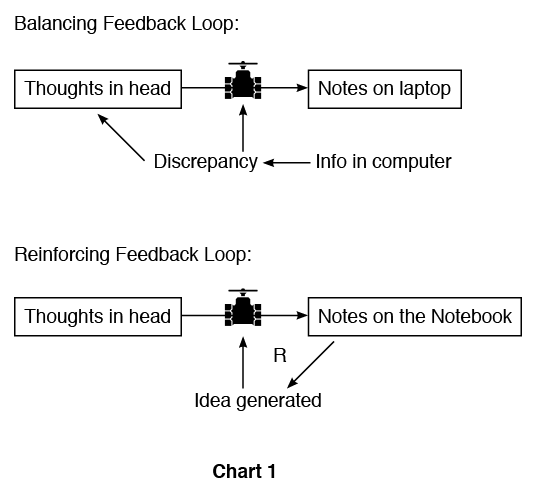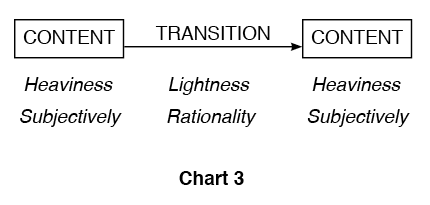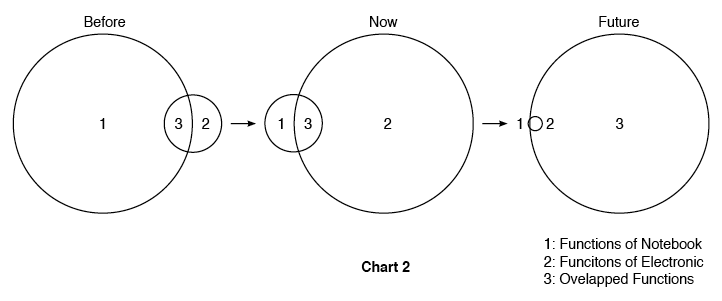A Future Notebook
Posted by Janson Cheng on November 1, 2014Here is the question: Why most students still keep bringing a hard-cover notebook to take notes while everyone has a laptop? In another word, at least for now, why a cutting-edge macbook couldn’t entirely replace a notebook devised half century ago in transferring out thoughts into visual content?
FOR PRESENT:
Let us take a look at how we interact with notebook verse laptop when we take notes. Imagining a drop of black ink, saturated into a matte paper, you picked one marker to emphasize the points in a stout way while the paper already curly and soaked… As you can see, there are multiple ways that you can interact with your notebook. On the contract, an idea in your head could only be transferred into visible content thru mechanical finger movements when you typing into your laptop. Moreover, it is a major leap jumping from an idea to an literal sentence. Additionally, you might type incorrectly.
But what is the pattern behinds in this two different interpretation processes? In Donella H. Meadows’s “Thinking in Systems: A Primer,” she introduces different feedback types based on a “system map” made of “stock” and ”flow” (Meadows 18). If we regard typing on laptop as a system (Chart1), like the temperature of a cup of hot coffee drops down until there is no discrepancy compares to it’s surrounding’s temperature, so ideas or thoughts in your head are moved by typing into the laptop until there is no discrepancy compares to interpreted information on the laptop. She calls this model “Balancing Feedback Loop”, whose duty is to equalize discrepancy. However, due to the multiple communicating channels, while you drawing on a notebook, new ideas may occasionally generated and applied them back to the paper. Thus ideas generated incrementally, which called “Reinforcing Feedback Loop”. Back to the system, Meadows states there are three elements a system is consist of: elements, interconnection and purpose. Moreover, the alternation within interconnection or purpose usually leads drastic changes (Meadows 11). In laptop case, the purpose is to move ideas from your head to laptop. Reversely, to create new ideas is the purpose when you use a notebook. Thus, it is extremely two different systems, which explain why we use notebook even though it is much more effective to type than write.

FOR FUTURE:
If you are meticulous about the details mentioned above, you might notice by transferring the function of laptop from a “Balancing feedback loop system” into a “Reinforcing feedback loop system”, notebooks could be replaced. In fact, Adobe recently announced one progress video called “The future of Adobe creative applications on Microsoft devices” that delineates the future of creating arts on a electronic device with low transaction cost. You might wonder if notebooks still survive in future?
Absolutely yes. The answer lies in the different functions between notebooks and electronic devices. The following diagram shows the functions of notebooks, electronics and their overlapped area changes in meta-history (Chart3). As far as we can see, with the astonishing evolution of technologies, in a short future, perhaps a new electronic device named SPIME may accomplish almost every tasks a notebook could do. Nevertheless, as you can see, something in the notebook still there, irreplaceably. What is it?
To find out, we need to introduce the relationship between “Content” and “Transition”, which is an important concept that I realized lately (Chart3). The innovation takes place today either in “Content” or the way to “Content”, which is “Transition”, Think about how many hours you will take from Queens to Union Square before we have the train system: We are buying time to make “Content” heavier by making “Transition” lighter. Consequently, we replace newspaper with “Flipboard” on iPhone or instead take carriages but call a taxi on “Uber” to shorten the “Transition”, in that to have the time to join the Halloween march or tasting a parfait from a Michelin restaurant opened in New York City lately. It is an irresistible truth that things are easily be replaced once it serves the function of being a “Transition” as a means, because it is judged by purely rationality, but “Content” usually lasts long, people regard it something meaningful, like writing letter or making a cup of coffee by hand.

In retrospect, a notebook do serve the functions of being a “Transition”, for instance, transacts information, temporary remains information, creating information. But also a “Content”, like being a solid stuff, inheritable, tangible, exclusive or safe. As you can see, for a notebook today, almost every functions in “Transition” and some functions in “Content” are able to be accomplished on your laptop, however something still not. Imagining a hand-draft paper with only one word written by Van Gogh, which could never be replaced in any rate, so as yours.
(In the featured image, my father’s new notebook is on the left, on the right is the one I used for 2 years. Right now, my notebook no longer serve any transition use or solid content, but a meaningful symbols)
